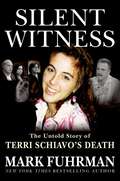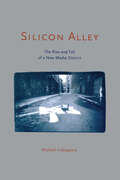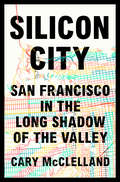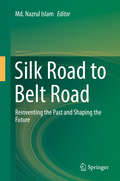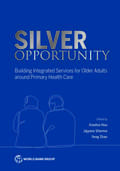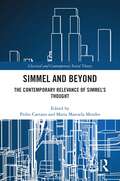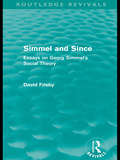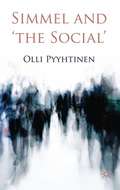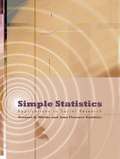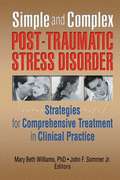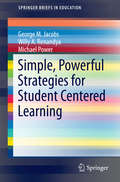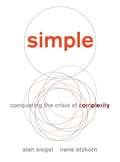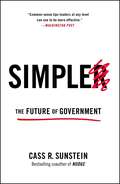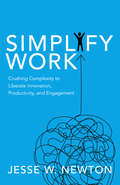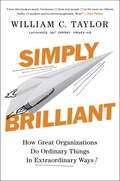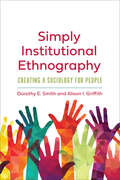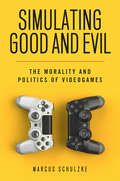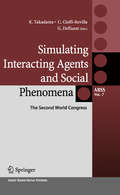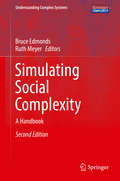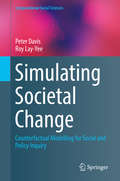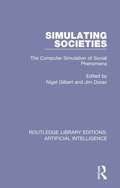- Table View
- List View
Silent Witness: The Untold Story of Terri Schiavo's Death
by Mark FuhrmanWe all watched Terri Schiavo die. The controversy around her case dominated the headlines and talk shows, going all the way to the U.S. Supreme Court, the White House, and the Vatican.And it's not over yet. Despite her death, the controversy lingers. In Silent Witness, former LAPD detective and New York Times bestselling author Mark Fuhrman applies his highly respected investigative skills to examine the medical evidence, legal case files, and police records. With the complete cooperation of Terri Schiavo's parents and siblings, as well as their medical and legal advisers, he conducts exclusive interviews with forensics experts and crucial witnesses, including friends, family members, and caregivers.Fuhrman's findings will answer these questions:What was Terri and Michael Schiavo's marriage really like?What happened the day Terri collapsed?What did Michael Schiavo do when he discovered Terri unconscious? How long did he wait before calling 911?What do medical records show about her condition when she was first admitted to the hospital?What will the autopsy say?The legal issues and ethical questions provoked by Terri Schiavo's extraordinary case may never be resolved. But the facts about her marriage, her condition when she collapsed, and her eventual death fifteen years later can be determined.With Silent Witness, Fuhrman goes beyond the legal aspects of the case and delves into the broader, human background of Terri Schiavo's short, sad life.
Silicon Alley: The Rise and Fall of a New Media District (Cultural Spaces)
by Michael IndergaardThe 1990s dawned with a belief that the digital revolution would radically transform our traditional notion of cities as places of commerce and industry. Many predicted that digital technology would render cities--or at least their economies--obsolete. Instead, precisely the opposite happened. The IT-intensive firms of the new economy needed to be plugged into a sizeable network of talent, something that established cities like New York and San Francisco provided in abundance. In addition to creating new types of jobs and luring thousands of workers back into the city, new media districts created a new technobohemian urban culture. With vignettes of the high-rollers in New York's new media economy and stories of wild parties in downtown lofts, Michael Indergaard introduces us to the players in this new economy, and explores this intersection of commerce and culture in 1990s New York. He also reveals how the dot-com crash laid bare the hidden connections between the so-called new economy of new media, and the ages old engines of New York wealth: real estate speculators and Wall Street. Chronicling the go-go years and ultimate crash of the new media district, Silicon Alley is a brilliant account of how hype forged a marriage of technology and finance, which in turn generated a new urban culture.
Silicon City: San Francisco In The Long Shadow Of The Valley
by Cary McClellandAn intimate, eye-opening portrait of San Francisco transformed by the tech boom. San Francisco is changing at warp speed. Famously home to artists and activists, and known as the birthplace of the Beats, the Black Panthers, and the LGBTQ movement, in recent decades the Bay Area has been reshaped by Silicon Valley, the engine of the new American economy. The richer the region gets, the more unequal and less diverse it becomes, and cracks in the city’s facade—rapid gentrification, an epidemic of evictions, rising crime, atrophied public institutions—have started to show. Inspired by Studs Terkel’s classic works of oral history, writer and filmmaker Cary McClelland spent several years interviewing people at the epicenter of the recent change, from venture capitalists and coders to politicians and protesters, from native sons and daughters to the city’s newest arrivals. The crisp and vivid stories of Silicon City’s diverse cast capture San Francisco as never before. The book opens with a longtime tour guide recounting the history of the original Gold Rush and observing how little the people of his city pay attention to its history; it ends on Fisherman’s Wharf, with the proprietor of an arcade game museum reminding us that even today’s technology will become relics of the past. In between we hear from people who have passed through Apple, Google, eBay, Intel, and the other big tech companies of our time. And we meet those who are experiencing the changes at the grassroots level: a homeless advocate in Haight-Ashbury, an Oakland rapper, a pawnbroker in the Mission, a man who helped dismantle and rebuild the Bay Bridge, and a woman who runs a tattoo parlor in the Castro. Silicon City masterfully weaves together a candid conversation across a divided community to create a dynamic portrait of a beloved city—and a cautionary tale for the entire country.
Silicon Valley Cybersecurity Conference: First Conference, SVCC 2020, San Jose, CA, USA, December 17–19, 2020, Revised Selected Papers (Communications in Computer and Information Science #1383)
by Thomas Austin Younghee Park Divyesh JadavThis book constitutes selected and revised papers from the First Silicon Valley Cybersecurity Conference, held in San Jose, USA, in December 2020. Due to the COVID-19 pandemic the conference was held in a virtual format. The 9 full papers and 6 short papers presented in this volume were thoroughly reviewed and selected from 30 submissions. They present most recent research on dependability, reliability, and security to address cyber-attacks, vulnerabilities,faults, and errors in networks and systems.
Silk Road to Belt Road: Reinventing the Past and Shaping the Future
by Md. Nazrul IslamThis volume approaches China’s Belt and Road Initiative as a process of culturalization, one that started with the Silk Road and continued over the millennium. In mainstream literature, the Belt and Road Initiative (BRI) has been portrayed as the geo-economic vision and geo-political ambition of China’s current leaders, intended to shape the future of the world. However, this volume argues that although geo-politics and geo-economy may play their part, the BRI more importantly creates a venue for the meeting of cultures by promoting people-to-people interaction and exchange. This volume explores the journey from the Silk-Road to Belt-Road by analyzing topics ranging from history to religion, from language to culture, and from environment to health. As such, scholars, academics, researchers, undergraduate and graduate students from the Humanities, Social Sciences, and Business will find an alternative approach to the Belt and Road Initiative.
Silver Opportunity Case Studies: Experiences with Building Integrated Services for Older Adults around Primary Health Care
by Feng Zhao Xiaohui Hou Jigyasa SharmaHealth care systems must be prepared to address the expanding and complex needs of an aging population. Rather than a 'silver challenge,' this situation should be seen as an opportunity to reevaluate and reorganize the health care delivery system holistically. Silver Opportunity Case Studies presents a comprehensive examination of care for older adults in diverse economic and geographic contexts through a collection of country and regional case studies. This collection of case studies complements the synthesis volume of global evidence--Silver Opportunity: Building Integrated Services for Older Adults around Primary Health Care--by offering practical insights for decision-making, sharing knowledge, and encouraging cross-learning. The book provides a deeper understanding of the complexities involved and highlights key issues and current practices at the country level. The overarching goal of the volume is to inform policy makers, health care professionals, and other stakeholders about effective practices for caring for older adults and to support the development of evidence-based policies that enhance their health and well-being.d well-being.
Silver Opportunity: Building Integrated Services for Older Adults around Primary Health Care
by Feng Zhao Xiaohui Hou Jigyasa SharmaWe live in a rapidly aging world, in which people who are age 60 and older outnumber children under the age of five. This book reveals large and growing gaps in care for older adults in countries at all income levels and shows how to leverage reforms for improving health outcomes for older adults and create healthier, more prosperous communities. Aimed at policy makers and other health and development stakeholders who want to promote healthier aging, Silver Opportunity compiles the latest evidence on care needs and gaps for aging populations. It argues that primary health care should be the cornerstone of integrated service delivery for older people, but primary health care systems must first build their capacity to respond to older people’s health needs. It presents an original framework for policy action to advance primary health care†“centered, integrated senior care; documents the experiences of pioneering countries in delivering community-based care to older people; and provides recommendations for decision-makers. The framework presents four policy levers with which to improve health care for seniors--financing, innovation, regulation, and evaluation and measurement--or FIRE. Finally, the book posits that by acting now, countries can leverage population aging to accelerate progress toward health equity and universal health coverage.
Simmel and Beyond: The Contemporary Relevance of Simmel’s Thought (Classical and Contemporary Social Theory)
by Pedro CaetanoBringing together the work of scholars from across Europe, this book shows how Simmel's categories can be used to explore contemporary issues and further shed light on trends characteristic of global modernity. Thematically organised around the major societal challenges currently faced by developed countries – those of making societies that are inclusive, reflexive and creative, sustainable, and democratic societies – it examines diverse phenomena, such as living in an increasingly multicultural societies, the social exclusion of vulnerable ethnic groups, the increasing concern with cyberbullying, the need to fight climate change, the rise of political populism, and the recruitment of youths from western countries to Islamic religious fundamentalism. Drawing on Simmel’s sociological theory and expounding new approaches to research inspired by his work, this volume emphasises the conceptual pillars of Simmelian thought, meanings, processes, and forms. As such, it will appeal to scholars of sociology and social theory with interests in the work of Simmel and its contemporary relevance.
Simmel and Since: Essays on Georg Simmel's Social Theory (Routledge Revivals)
by David FrisbyOriginally published in 1992, this book, written by one of the world's leading experts on Simmel, provides a fascinating set of insights into a thinker who is fast becoming recognized as the sociologist of modernity; an indispensible resource in confronting post-modernity. It examines the relevance of his work in relation to contemporary debates on culture, aesthetics and modernity.
Simmel and ‘the Social’
by Olli PyyhtinenThis book argues for the centrality of Georg Simmel's social theory to the relational and processual emphases that are often considered as much more recent developments in social theory. Situating Simmel's work in particular with respect to New Vitalism and Bruno Latour's work, the book shows that Simmel has still an enormous amount to contribute.
Simple Sabotage: A Modern Field Manual for Detecting and Rooting Out Everyday Behaviors That Undermine Your Workplace
by Robert M. Galford Bob Frisch Cary GreeneInspired by the Simple Sabotage Field Manual released by the Office of Strategic Services in 1944 to train European resistors, this is the essential handbook to help stamp out unintentional sabotage in any working group, from major corporations to volunteer PTA committees.In 1944, the Office of Strategic Services (OSS)--the predecessor of today's CIA--issued the Simple Sabotage Field Manual that detailed sabotage techniques designed to demoralize the enemy. One section focused on eight incredibly subtle--and devastatingly destructive--tactics for sabotaging the decision-making processes of organizations. While the manual was written decades ago, these sabotage tactics thrive undetected in organizations today: Insist on doing everything through channels. Make speeches. Talk as frequently as possible and at great length. Refer all matters to committees. Bring up irrelevant issues as frequently as possible. Haggle over precise wordings of communications. Refer back to matters already decided upon and attempt to question the advisability of that decision. Advocate caution and urge fellow-conferees to avoid haste that might result in embarrassments or difficulties later on. Be worried about the propriety of any decision.Everyone has been faced with someone who has used these tactics, even when they have meant well. Filled with proven strategies and techniques, this brief, clever book outlines the counter-sabotage measures to detect and reduce the impact of these eight classic sabotage tactics to improve productivity, spur creativity, and engender better collegial relationships.
Simple Statistics: Applications in Social Research
by Terance D. Miethe Jane Florence GauthierThe efficient use of statistics can transform excellent research into dynamic, persuasive scholarship. To demystify the process of calculating data, Simple Statistics: Applications in Social Research provides a concise introduction to basic social statistics.
Simple Truths of Leadership: 52 Ways to Be a Servant Leader and Build Trust
by Ken Blanchard Randy ConleyFifty-two essential principles that are easy to implement and practice: &“The ultimate guide to servant leadership.&” —Marshall Goldsmith, New York Times–bestselling author of Mojo Effective leadership is an influence process in which leaders implement everyday common-sense approaches that help people and organizations thrive. Yet somehow, many of these fundamental principles are still missing from most workplaces. In this book, legendary servant leadership expert and #1 New York Times–bestselling author Ken Blanchard and his colleague Randy Conley, a thought leader known for his expertise in the field of trust, share fifty-two Simple Truths that will help leaders everywhere make common-sense leadership common practice. Discover profound, memorable—and in some cases counterintuitive—wisdom such as: • Who should make the first move to extend trust • What role a successful apology plays in building trust • When to use different strokes (leadership styles) for different folks—and for the same folks • Where the most important part of leadership happens • How to create autonomy through boundaries • Why the key to developing people is catching them doing something right A fun, easy read that will make a positive difference in leadership and organizational success, Simple Truths of Leadershipshows how to incorporate simple but essential practices into your leadership style, build trust through servant leadership, and enhance your own life and the lives of everyone around you.
Simple and Complex Post-Traumatic Stress Disorder: Strategies for Comprehensive Treatment in Clinical Practice
by Mary Beth Williams John F Sommer Jr.Discover the latest treatment strategies from the leading experts in the field of trauma!This unique book, by the authors of the classic Handbook of Post-Traumatic Therapy, provides the “how to” of clinical practice techniques in a variety of settings with a variety of clients. Simple and Complex Post-Traumatic Stress Disorder: Strategies for Comprehensive Treatment in Clinical Practice delivers state-of-the-art techniques and information to help traumatized individuals, groups, families, and communities. From critical incident debriefing to treating combat veterans with longstanding trauma, it covers the full spectrum of PTSD clients and effective treatments. This valuable book assembles some of the most highly respected experts in trauma studies to discuss the practical applications of their research and their experience treating clients with PTSD. Simple and Complex Post-Traumatic Stress Disorder addresses concerns about the efficacy of critical incident stress debriefing, examines the value of a variety of innovative treatment methods, and explores the differences between treating complex PTSD and the aftermath of a one-time traumatic event. Simple and Complex Post-Traumatic Stress Disorder discusses the issues, stages, and modalities of PTSD treatment, including: assessment and diagnosis psychopharmacological treatment cognitive behavioral treatment short-term treatment group treatments treatment strategies for traumatized children, families, hostages, police, and veterans media issuesSimple and Complex Post-Traumatic Stress Disorder is an indispensable resource for clinicians, researchers, law enforcement officials, and scholars in the field of trauma.
Simple, Powerful Strategies for Student Centered Learning
by George Martin Jacobs Willy Ardian Renandya Michael PowerThis book reminds us teachers about all the little things we can do to be more student-centric. It shows teachers how to "walk the walk," and shows teacher educators how to guide colleagues along a student-centered path. The book examines why we should and how we can promote student-student interaction to enable students to learn more and enjoy the process. It also offers simple but effective strategies for enhancing student motivation, a factor that many experts consider to be the most important determinant of success in educational endeavors. In addition, it examines diversity, particularly the many differences that exist among students, and explains simple, easy strategies for how this diversity can be not only taken into consideration, but actively celebrated.
Simple: Conquering the Crisis of Complexity
by Alan Siegel Irene EtzkornFor decades, Alan Siegel and Irene Etzkorn have championed simplicity as a competitive advantage and a consumer right. Consulting with businesses and organizations around the world to streamline products, services, processes and communications, they have achieved dramatic results. In SIMPLE, the culmination of their work together, Siegel and Etzkorn show us how having empathy, striving for clarity, and distilling your message can reduce the distance between company and customer, hospital and patient, government and citizen-and increase your bottom line. Examining the best and worst practices of an array of organizations big and small-including the IRS, Google, Philips, Trader Joe's, Chubb Insurance, and ING Direct, and many more-Siegel and Etzkorn recast simplicity as a mindset, a design aesthetic, and a writing technique. In these illuminating pages you will discover, among other things:Why the Flip camera became roadkill in the wake of the iPhoneWhat SIMPLE idea allowed the Cleveland Clinic to improve care and increase revenueHow OXO designed a measuring cup that sold a million units in its first 18 months on the marketWhere Target got the idea for their "ClearRX" prescription systemHow New York City simplified its unwieldy bureaucracy with three simple numbers By exposing the overly complex things we encounter every day, SIMPLE reveals the reasons we allow confusion to persist, inspires us to seek clarity, and explores how social media is empowering consumers to demand simplicity. The next big idea in business is SIMPLE.
Simpler
by Cass R. SunsteinSimpler government arrived four years ago. It helped put money in your pocket. It saved hours of your time. It improved your children's diet, lengthened your life span, and benefited businesses large and small. It did so by issuing fewer regulations, by insisting on smarter regulations, and by eliminating or improving old regulations. Cass R. Sunstein, as administrator of the most powerful White House office you've never heard of, oversaw it and explains how it works, why government will never be the same again (thank goodness), and what must happen in the future. Cutting-edge research in behavioral economics has influenced business and politics. Long at the forefront of that research, Sunstein, for three years President Obama's "regulatory czar" heading the White House Office of Information and Regulatory Affairs, oversaw a far-reaching restructuring of America's regulatory state. In this highly anticipated book, Sunstein pulls back the curtain to show what was done, why Americans are better off as a result, and what the future has in store. The evidence is all around you, and more is coming soon. Simplified mortgages and student loan applications. Scorecards for colleges and universities. Improved labeling of food and energy-efficient appliances and cars. Calories printed on chain restaurant menus. Healthier food in public schools. Backed by historic executive orders ensuring transparency and accountability, simpler government can be found in new initiatives that save money and time, improve health, and lengthen lives. Simpler: The Future of Government will transform what you think government can and should accomplish.
Simplify Work: Crushing Complexity to Liberate Innovation, Productivity, and Engagement
by Jesse W. NewtonIn urgent response to the epidemic of crippling complexity affecting organizations around the world, Simplify Work reveals the common sources of this virus and outlines practical steps that can be taken to liberate innovation, productivity, and engagement. Complexity is like a vine that gradually grows and expands, wreaking havoc in organizations and individual lives. Growing complexity has traditionally been met with added structures, processes, committees and systems. Consequently, organizations often become a complicated mess, clouding strategic focus, slowing innovation and breeding complacency. It is no wonder that large organizations around the world are failing at an increasing rate and employee engagement levels have never been so low. Simplify Work reveals the typical drivers of complexity and provides a practical method for simplifying work. Inside, global management consultant Jesse Newton delivers a newfound clarity on the case for simplification and the steps organizations and individuals need to take to unleash its potential. He reveals the common drivers of debilitating complexity and provides a recipe for reducing and removing those things getting in the way of peak performance. Based on the research and experiences of a recognized organization effectiveness expert, Simplify Work leaves readers inspired and equipped to create a new liberating reality in both their organization and their life.
Simply Brilliant: How Great Organizations Do Ordinary Things in Extraordinary Ways
by William C. TaylorCofounder of Fast Company magazine and bestselling author of Mavericks at Work and Practically Radical shows how true business innovation can spring from the unlikeliest places. Far away from Silicon Valley, in familiar, traditional, even unglamorous fields, ordinary people are unleashing extraordinary advances that amaze customers, energize employees, and create huge economic value. Their secret? They understand that the work of inventing the future doesn't just belong to geeks designing mobile apps and virtual-reality headsets, or to social-media entrepreneurs hoping to launch the next Facebook. Some of today's most compelling organizations are doing brilliant things in simple settings such as retail banks, office cleaning companies, department stores, small hospitals, and auto dealerships.William C. Taylor, cofounder of Fast Company and best-selling author of Practically Radical, traveled thousands of miles to visit these hotbeds of simple brilliance and unearth the principles and practices behind their success. He offers fascinating case studies and powerful lessons that you can apply to do ordinary things in extraordinary ways, regardless of your industr yor profession. Consider, for instance, how... ·Miami Beach's dazzling 1111 Lincoln Road reimagined the humble parking garage as a high-profile public space that hosts weddings, yoga classes, and celebrity gatherings.·USAA, the financial-services giant that provides soldiers and their families with insurance and banking products, inspires frontline employees to deliver legendary service by immersing them in military culture.·Pal's Sudden Service, a fast-food chain with a cult following, serves up burgers and fries with such speed and accuracy that companies from other industries pay to learn from its astonishing discipline. ·Lincoln Electric, a manufacturer based in Euclid, Ohio, dominates its ultracompetitive markets with a fierce devotion to quality and productivity. But the key to its prosperity is a share-the-wealth model that gives everybody a sense of security and a piece of the action. It has maintained a strict no-layoff pledge since 1958. As Taylor writes: "The story of this book, its message for leaders who aim to do something important and build something great, is both simple and subversive: In a time of wrenching disruptions and exhilarating advances, of unrelenting turmoil and unlimited promise, the future is open to everybody. The thrill of breakthrough creativity and breakaway performance . . . can be summoned in all sorts of industries and all walks of life, if leaders can reimagine what's possible in their fields." Simply Brilliant shows you how.From the Hardcover edition.
Simply Institutional Ethnography: Creating a Sociology for People
by Dorothy E. Smith Alison I. GriffithInstitutional ethnography (IE) originated as a feminist alternative to sociologies defining people as the objects of study. Instead, IE explores the social relations that dominate the life of the particular subject in focus. Simply Institutional Ethnography is written by two pioneers in the field and grounded in decades of ground-breaking work. Dorothy Smith and Alison Griffith lay out the basics of how institutional ethnography proceeds as a sociology. The book introduces the concepts – Discourse, Work, Text – that institutional ethnographers have found to be key ideas used to organize what they learn from the study of people’s experience. Simply Institutional Ethnography builds an ethnography that makes this material visible as coordinated sequences of social relations that reach beyond the particularities of local experience. In explicating the foundations of IE and its principal concepts, Simply Institutional Ethnography reflects on the ways in which the field may move forward.
Simulating Good and Evil: The Morality and Politics of Videogames
by Marcus SchulzkeSimulating Good and Evil shows that the moral panic surrounding violent videogames is deeply misguided, and often politically motivated, but that games are nevertheless morally important. Simulated actions are morally defensible because they take place outside the real world and do not inflict real harms. Decades of research purporting to show that videogames are immoral has failed to produce convincing evidence of this. However, games are morally important because they simulate decisions that would have moral weight if they were set in the real world. Videogames should be seen as spaces in which players may experiment with moral reasoning strategies without taking any actions that would themselves be subject to moral evaluation. Some videogame content may be upsetting or offensive, but mere offense does not necessarily indicate a moral problem. Upsetting content is best understood by applying existing theories for evaluating political ideologies and offensive speech.
Simulating Interacting Agents and Social Phenomena
by Claudio Cioffi-Revilla Guillaume Deffuant Keiki TakadamaAgent-based modeling and social simulation have emerged as an interdisciplinary area of social science that includes computational economics, organizational science, social dynamics, and complex systems. This area contributes to enriching our understanding of the fundamental processes of social phenomena caused by complex interactions among agents. Bringing together diverse approaches to social simulation and research agendas, this book presents a unique collection of contributions from the Second World Congress on Social Simulation, held in 2008 at George Mason University in Washington DC, USA. This book in particular includes articles on norms, diffusion, social networks, economy, markets and organizations, computational modeling, and programming environments, providing new hypotheses and theories, new simulation experiments compared with various data sets, and new methods for model design and development. These works emerged from a global and interdisciplinary scientific community of the three regional scientific associations for social simulation: the North American Association for Computational Social and Organizational Science (NAACSOS; now the Computational Social Science Society, CSSS), the European Social Simulation Association (ESSA), and the Pacific Asian Association for Agent-bBased Approach in Social Systems Sciences (PAAA).
Simulating Social Complexity: A Handbook (Understanding Complex Systems)
by Bruce Edmonds Ruth MeyerSocial systems are among the most complex known. This poses particular problems for those who wish to understand them. The complexity often makes analytic approaches infeasible and natural language approaches inadequate for relating intricate cause and effect. However, individual- and agent-based computational approaches hold out the possibility of new and deeper understanding of such systems. Simulating Social Complexity examines all aspects of using agent- or individual-based simulation. This approach represents systems as individual elements having each their own set of differing states and internal processes. The interactions between elements in the simulation represent interactions in the target systems. What makes these elements "social" is that they are usefully interpretable as interacting elements of an observed society. In this, the focus is on human society, but can be extended to include social animals or artificial agents where such work enhances our understanding of human society. The phenomena of interest then result (emerge) from the dynamics of the interaction of social actors in an essential way and are usually not easily simplifiable by, for example, considering only representative actors. The introduction of accessible agent-based modelling allows the representation of social complexity in a more natural and direct manner than previous techniques. In particular, it is no longer necessary to distort a model with the introduction of overly strong assumptions simply in order to obtain analytic tractability. This makes agent-based modelling relatively accessible to a range of scientists. The outcomes of such models can be displayed and animated in ways that also make them more interpretable by experts and stakeholders. This handbook is intended to help in the process of maturation of this new field. It brings together, through the collaborative effort of many leading researchers, summaries of the best thinking and practice in this area and constitutes a reference point for standards against which future methodological advances are judged. This book will help those entering into the field to avoid "reinventing the wheel" each time, but it will also help those already in the field by providing accessible overviews of current thought. The material is divided into four sections: Introductory, Methodology, Mechanisms, and Applications. Each chapter starts with a very brief section called 'Why read this chapter?' followed by an abstract, which summarizes the content of the chapter. Each chapter also ends with a section of 'Further Reading' briefly describing three to eight items that a newcomer might read next.
Simulating Societal Change: Counterfactual Modelling for Social and Policy Inquiry (Computational Social Sciences)
by Peter Davis Roy Lay-YeeThis book presents a method for creating a working model of society, using data systems and simulation techniques, that can be used for testing propositions of scientific and policy nature. The model is based on the example of New Zealand, but will be applicable to other countries. It is expected that collaborators in other countries can emulate this example with their data systems for teaching and policy purposes, producing a cross-national "collaboratory". This enterprise will evolve with, and to a degree independently of, the book itself, with a supporting website as well as teaching and scientific initiatives. Readers of this text will, for the first time, have a simulation-based working model of society that can be interrogated for policy and substantive purposes. This book will appeal to researchers and professionals from various disciplines working within the social sciences, particularly on matters of demography and public policy.
Simulating Societies: The Computer Simulation of Social Phenomena (Routledge Library Editions: Artificial Intelligence #6)
by Nigel Gilbert Jim DoranThe most exciting and productive areas of academic inquiry are often where the interests of two disciplines meet. This is certainly the case for the subject of this book, originally published in 1994, which explores the contribution that computer-based modelling and artificial intelligence can make to understanding fundamental issues in social science. Simulating Societies shows how computer simulations can help to clarify theoretical approaches, contribute to the evaluation of alternative theories, and illuminate one of the major issues of the social sciences: how social phenomena can "emerge" from individual action. The authors discuss how simulation models can be constructed using recently developed artificial intelligence techniques and they consider the methodological issues involved in using such models for theory development, testing and experiment. The introductory chapters situate the book within social science, and suggest why the time was ripe for significant progress, before defining basic terminology, showing how simulation has been used to theorize about organizations, and indicating through examples some of the fundamental issues involved in simulation. The main body of the text provides case studies drawn from economics, anthropology, archaeology, planning, social psychology and sociology. The appeal of this path-breaking book was twofold. It offered an essential introduction to simulation for social scientists and it provided case study applications for computer scientists interested in the latest advances in the burgeoning area of distributed artificial intelligence (DAI) at the time.
